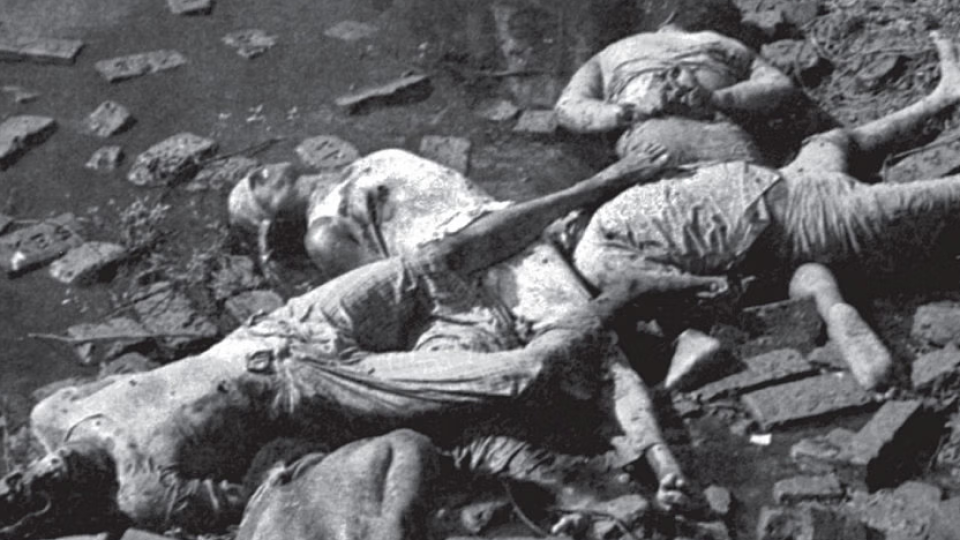December 14, 2023
DHAKA – “Every night, the Pakistan army and their Bihari collaborators would bring truckloads of people on that bridge,” Mohammad Ali said, pointing to the Gabtoli-Aminbazar bridge in Dhaka, “We heard sounds of shooting and bodies falling off the bridge one after another in the Turag river. I cannot remember a single night during the war when the military did not kill people on that bridge.”
Mohammad Ali, 75, is a boatman from Isakabad village of Kaundia union in Savar. He has been ferrying passengers across the Turag for six decades, including during the war. The Gabtoli-Aminbazar bridge is clearly visible from his village, just opposite Gabtoli, along the northern bank of the Turag.
Even three years ago, an old steel bridge used to connect the two banks of the river. The old bridge has now been replaced by an eight-lane concrete bridge that connects Dhaka with the southern districts. But back in 1971, the bridge served a whole different purpose for the Pakistan army and their local collaborators: it was turned into a killing field.
Freedom fighter and Liberation War researcher Dr MA Hasan gave a similar account of the killings on the bridge during the 1971 war.
“Pakistan army and their Bihari collaborators killed an estimated 15,000 people on that bridge,” he said.
More than five decades after independence, the bridge is not officially recognised as a killing field.
Gabtoli bridge is just one of many such killing fields scattered all over Mirpur.
According to Liberation War and genocide researchers, the entire Mirpur neighbourhood was turned into a massive killing field in 1971. Immediately after the war, researchers identified 76 killing fields in Dhaka, 27 of them in Mirpur alone.
But the government did not include any of these killing fields in official records, genocide researchers MA Hasan, Prof Muntassir Mamoon and Prof Shahriar Kabir told The Daily Star.
Of these 27 killing fields, 17 are in no way recognisable. Of the rest 10, only the Jalladkhana killing field has been fully preserved by the Liberation War Museum. The one inside the Government Bangla College in Mirpur has been partially preserved by the college authorities.
The Daily Star visited eight killing fields in Mirpur recently, and found them occupied by multi-storied buildings, business establishments and garage. Two are used as landfills, while one has been devoured by the Turag.
NO ONE KNOWS
No one is really sure about the exact number of the killing fields in the country.
A study conducted in 40 districts so far by 1971 Genocide-Torture Archive and Museum Trust found 855 killing fields, 1,264 mass graves and 1,118 torture centres in those districts. The Trust is making GPS (Global Positioning System) maps of those sites.
In its own research, the War Crimes Facts Finding Committee has identified 5,000 killing fields. The committee has produced GPS maps of 1,040 of those.
Genocide researches say successive governments had taken some initiatives to prepare a list of killing fields, but they came to nothing.
“The government could not prepare a list of the killing fields even 52 years after our liberation. It is a complete failure. The bureaucratic tangle is a major barrier. Bureaucrats do not want to involve researchers in such projects,” said eminent historian Prof Muntassir Mamoon, also chairperson of 1971: Genocide-Torture Archive and Museum Trust.
Bangladesh’s Liberation War is one of the bloodiest. In just nine months, an estimated 30 lakh people were killed, some researchers say. They add that this figure does not include the estimated 3-5 lakh Bangladeshis who died of cholera, malnutrition and other diseases in Indian refugee camps where they took shelter to save their lives.
The plan for this large-scale massacre was set even before the war began.
“Kill three million of them, and the rest will eat out of our hands,” Pakistan president Yahya Khan told his generals in a military conference in February 1971, according to Massacre: The Tragedy at Bangla Desh and the Phenomenon of Mass Slaughter Throughout History by eminent writer Robert Payne.
WAR CRIMES TRIAL AND KILLING FIELDS
Although the genocide took place all over Bangladesh, certain killing fields were notorious for committing systematic mass murders.
Incidents of genocide and torture in many such killing fields and torture centres came up very prominently during the war crimes trial. The International Crimes Tribunal convicted many infamous war criminals for acts of genocide and crimes against humanity in those killing fields and torture centres.
So far, the tribunal sentenced 143 war criminals to death, lifetime imprisonment and other punishments for committing genocide and other war crimes. Of them, 102 were given death penalty.
On a random basis, The Daily Star has analysed the verdicts relating to 63 such convicted war criminals. Two criteria were considered for the selection — those who were given death sentences for any war crimes anywhere in the country and those who were given death or jail sentences for committing genocide and other war crimes in specific killing fields or torture centres.
The analysis shows 41 of them committed acts of genocide in at least 37 killing fields and torture centres in 16 districts, as presented in the map.
None of those sites are officially recognised as killing fields or torture centres.
“If the government really wants to prepare the list of killing fields and torture centres, it should not take more than two months. It is shameful that the Liberation War affairs ministry made no effort to list the killing fields that were recognised by the International Crimes Tribunal,” said Dr Mahfuzur Rahman, chairman of Bangladesher Mukti Shongram O Gobeshona Kendra Trust.
Talking to The Daily Star, Liberation War Affairs Minister AKM Mozammel Haque said, “It would have been better if we had a complete list. However, we will take steps about the killing fields that were proven as such at the International Crimes Tribunal after you publish reports on them.”


